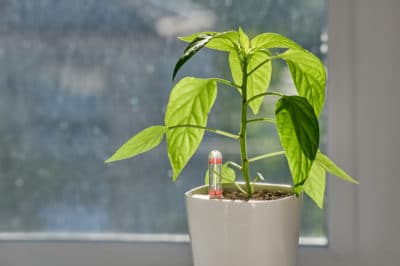Environment
You will need a climate controlled space. A greenhouse that can be heated and has electricity is ideal. Otherwise, utilize a room in your house where you can keep the temperature around 75-80°F (23-26°C).
Start seeds in simple seeding trays. Soak them for 2-8 hours in water prior to planting. Keep them warm and moist until sprouting. Seeding trays with lids or covered with stretch plastic worm great for holding in moisture and keeping the seeds warm.
The room or greenhouse will need lights that attach somewhere overhead and can be lowered and raised easily. There’s no need to purchase fancy lighting, simple fluorescents work great.
Seedling Care
When sprouts emerge, immediately get them under the lights. Lights should hand within 3 inches of the seedlings, providing them with the most direct light possible. If lights are unavailable many gardeners have success by placing them in a well-lit window. They may stretch out trying to reach light and end up gangly, but it won’t compromise the flavor of the fruit.
Keep the soil moist, but avoid getting foliage wet. This will help to prevent damping off and fungus infection. As the seedlings grow, raise the lighting so that it stays at 3 inches above the tallest plants.
Transplant your seedlings when they have four true leaves. They will need to go into a 4-inch or larger pot to accommodate growing roots. If at any point your pepper plant appears rootbound by exhibiting die-back or slow growth, transplant it into a larger pot.
Keep them under the lights for between 14 and 16 hours each day. Nighttime temperatures should get no lower than 70°F (21°C).
Pollination
Indoor peppers need to be hand pollinated. There aren’t any bees or bugs to do the job indoors, so it’s up to you. When flowers appear on your pepper plants, use a Q-tip to transfer some pollen from a male flower’s anther onto the stigma of a female flower.
This is simple after some quick research. The anthers are covered in sticky pollen. The stigma juts out of the middle of a pollen-free female flower.
Tips and Tricks
Here are a few tips for growing peppers successfully indoors:
- Rich well-draining soil
- Consistant watering
- Aluminum foil to reflect light
Add cardbard covered with aluminum foil to reflect more light back at your plants. Find your own perfect indoor growing system for beatiful peppers.
